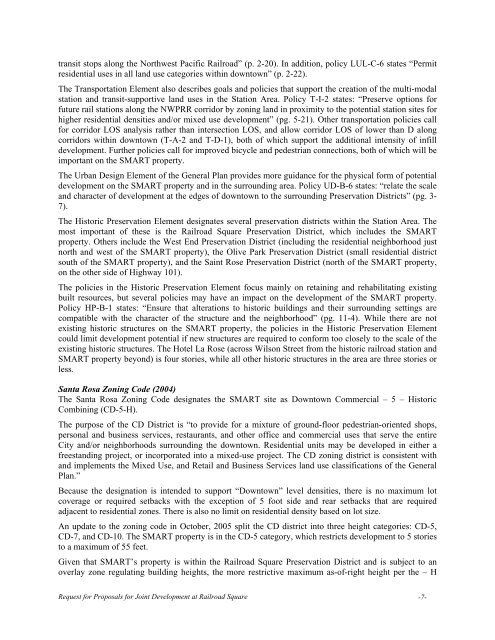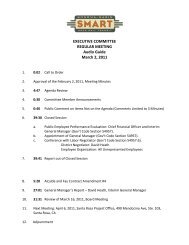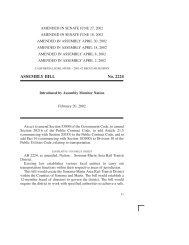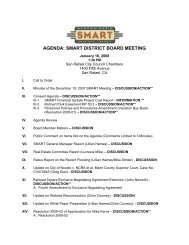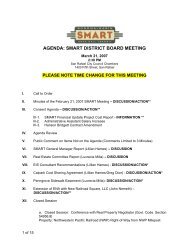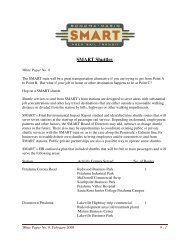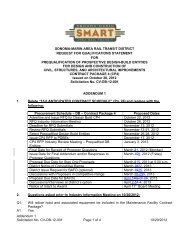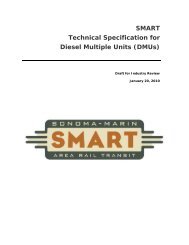Board Packet 01 18 06 - Sonoma Marin Area Rail Transit - Home Page
Board Packet 01 18 06 - Sonoma Marin Area Rail Transit - Home Page
Board Packet 01 18 06 - Sonoma Marin Area Rail Transit - Home Page
You also want an ePaper? Increase the reach of your titles
YUMPU automatically turns print PDFs into web optimized ePapers that Google loves.
transit stops along the Northwest Pacific <strong>Rail</strong>road” (p. 2-20). In addition, policy LUL-C-6 states “Permit<br />
residential uses in all land use categories within downtown” (p. 2-22).<br />
The Transportation Element also describes goals and policies that support the creation of the multi-modal<br />
station and transit-supportive land uses in the Station <strong>Area</strong>. Policy T-I-2 states: “Preserve options for<br />
future rail stations along the NWPRR corridor by zoning land in proximity to the potential station sites for<br />
higher residential densities and/or mixed use development” (pg. 5-21). Other transportation policies call<br />
for corridor LOS analysis rather than intersection LOS, and allow corridor LOS of lower than D along<br />
corridors within downtown (T-A-2 and T-D-1), both of which support the additional intensity of infill<br />
development. Further policies call for improved bicycle and pedestrian connections, both of which will be<br />
important on the SMART property.<br />
The Urban Design Element of the General Plan provides more guidance for the physical form of potential<br />
development on the SMART property and in the surrounding area. Policy UD-B-6 states: “relate the scale<br />
and character of development at the edges of downtown to the surrounding Preservation Districts” (pg. 3-<br />
7).<br />
The Historic Preservation Element designates several preservation districts within the Station <strong>Area</strong>. The<br />
most important of these is the <strong>Rail</strong>road Square Preservation District, which includes the SMART<br />
property. Others include the West End Preservation District (including the residential neighborhood just<br />
north and west of the SMART property), the Olive Park Preservation District (small residential district<br />
south of the SMART property), and the Saint Rose Preservation District (north of the SMART property,<br />
on the other side of Highway 1<strong>01</strong>).<br />
The policies in the Historic Preservation Element focus mainly on retaining and rehabilitating existing<br />
built resources, but several policies may have an impact on the development of the SMART property.<br />
Policy HP-B-1 states: “Ensure that alterations to historic buildings and their surrounding settings are<br />
compatible with the character of the structure and the neighborhood” (pg. 11-4). While there are not<br />
existing historic structures on the SMART property, the policies in the Historic Preservation Element<br />
could limit development potential if new structures are required to conform too closely to the scale of the<br />
existing historic structures. The Hotel La Rose (across Wilson Street from the historic railroad station and<br />
SMART property beyond) is four stories, while all other historic structures in the area are three stories or<br />
less.<br />
Santa Rosa Zoning Code (2004)<br />
The Santa Rosa Zoning Code designates the SMART site as Downtown Commercial – 5 – Historic<br />
Combining (CD-5-H).<br />
The purpose of the CD District is “to provide for a mixture of ground-floor pedestrian-oriented shops,<br />
personal and business services, restaurants, and other office and commercial uses that serve the entire<br />
City and/or neighborhoods surrounding the downtown. Residential units may be developed in either a<br />
freestanding project, or incorporated into a mixed-use project. The CD zoning district is consistent with<br />
and implements the Mixed Use, and Retail and Business Services land use classifications of the General<br />
Plan.”<br />
Because the designation is intended to support “Downtown” level densities, there is no maximum lot<br />
coverage or required setbacks with the exception of 5 foot side and rear setbacks that are required<br />
adjacent to residential zones. There is also no limit on residential density based on lot size.<br />
An update to the zoning code in October, 2005 split the CD district into three height categories: CD-5,<br />
CD-7, and CD-10. The SMART property is in the CD-5 category, which restricts development to 5 stories<br />
to a maximum of 55 feet.<br />
Given that SMART’s property is within the <strong>Rail</strong>road Square Preservation District and is subject to an<br />
overlay zone regulating building heights, the more restrictive maximum as-of-right height per the – H<br />
Request for Proposals for Joint Development at <strong>Rail</strong>road Square -7-


